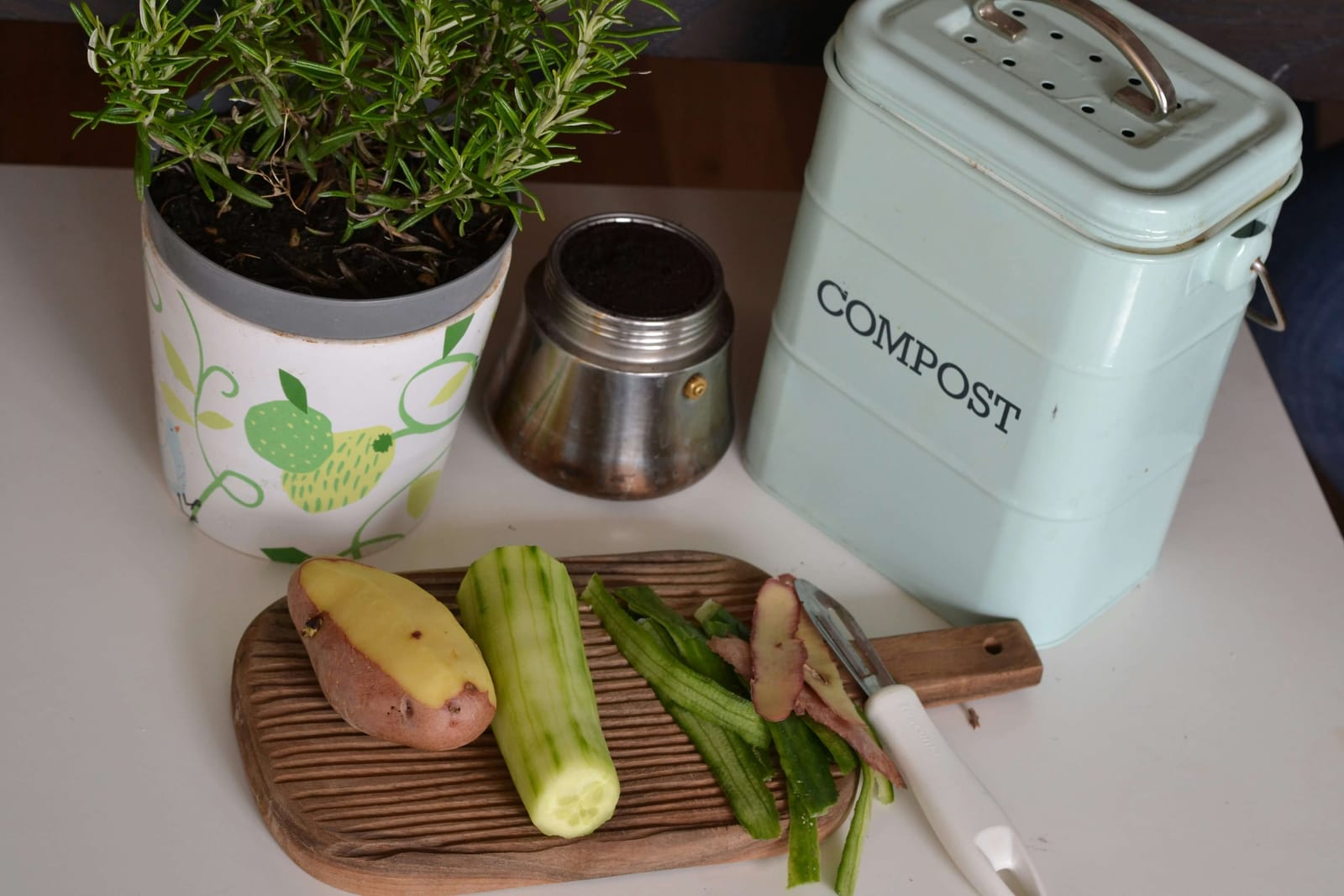Have you ever faced the fridge or freezer dilemma, where your ice cream turns into a frosty soup or your frozen peas become an icy block? The key to solving this chilly mystery lies in having the right tools: the best refrigerator thermometers and freezer thermometers. These gadgets are more than just temperature tellers; they're the guardians of your groceries, ensuring that everything from your leafy greens to your favorite frozen treats is kept in the ideal conditions. With these thermometers in place, you can wave goodbye to the days of unpredictable food freshness and embrace a world where every opening of the fridge or freezer door is a moment of confidence and satisfaction!
🤝 As an Amazon Associate, we earn from qualifying purchases made through our links, at ZERO additional cost to you.
5 Best Thermometers for Refrigerators and Freezers
- Best Overall: Rubbermaid Thermometer
- Editor's Choice: Taylor Precision Thermometer
- Best on a Budget: 4. Cooper-Atkins Thermometer
- Best Splurge: AcuRite Digital Wireless Thermometer
- Best Waterproof: Vouloir Waterproof Thermometer
1. Best Overall
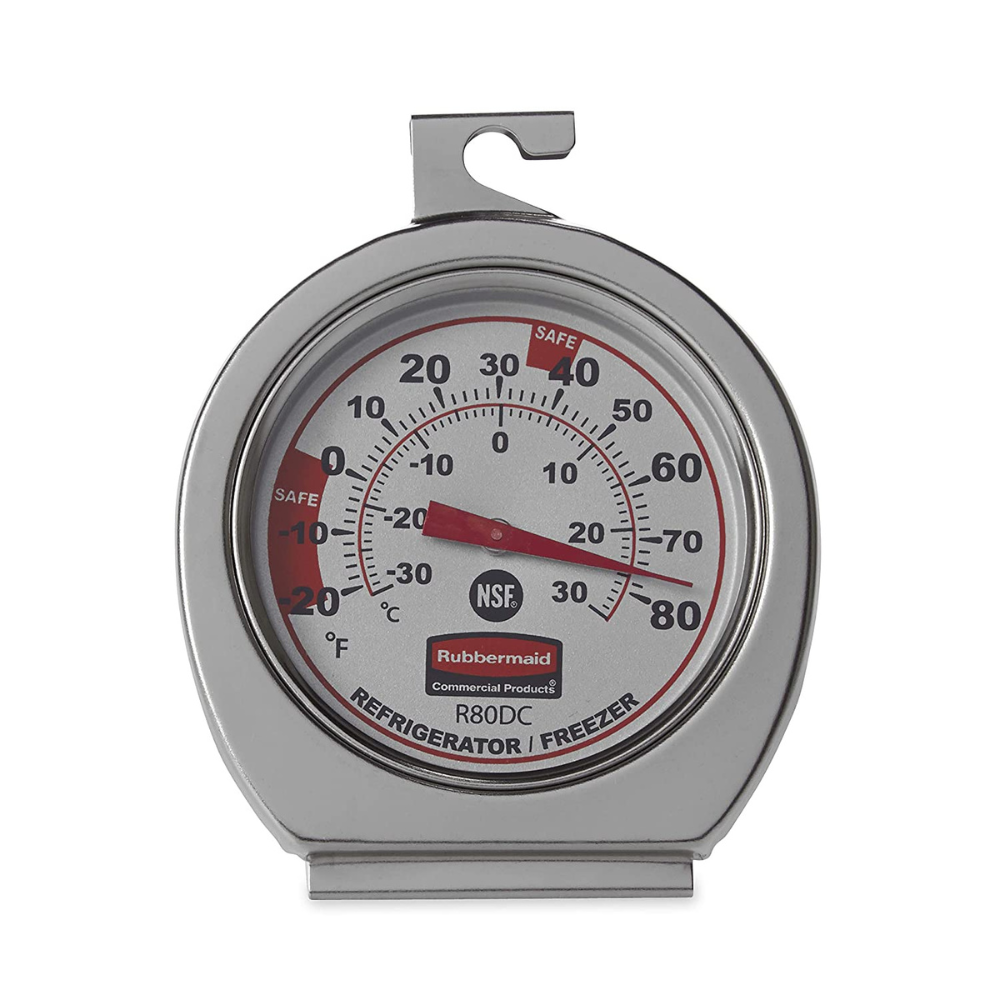
Rubbermaid Thermometer
Rubbermaid is a reputable brand, known for durability and reliability. Its thermometer offers both durability with its stainless steel construction and accuracy with its easy-to-read dial. It’s an all-rounder that can be trusted to deliver consistent performance.
What We Love:
- Battery-Free Operation: No need to worry about battery replacements.
- High Accuracy: Measures within a -/+ 2°F range, ensuring food safety.
- Durable Design: Made with a stainless steel casing and a shatterproof lens.
- NSF Certified: Meets the stringent standards for food and kitchen safety.
- Versatile Use: Ideal for standard fridges, mini-fridges, coolers, and freezers.
- Easy-to-Read: Large analog display with a clearly marked needle.
- Hangable: Convenient hanging tab for easy placement.
What to Keep in Mind:
- No Alerts: Won't notify you if the temperature falls out of a safe range.
Why It Might Be Right for You:
If you're someone who values long-lasting, no-fuss kitchen tools, the Rubbermaid Freezer/Refrigerator Thermometer is your match. Perfect for those who appreciate the classic reliability of a mechanical thermometer, its stainless steel construction and shatterproof lens mean it's built to last. Ideal for anyone from culinary enthusiasts to busy parents, this thermometer offers simplicity and accuracy without the need for batteries.
Customer Review (source: Amazon)
In my rental, I realized the fridge and freezer weren't at the correct temperatures. So, I picked up this recommended thermometer to ensure food safety. After letting it sit for 12 hours, I found that neither was at the safe temperature range. Thankfully, they are now. With health and budget concerns, I can't take chances with spoiled food. This thermometer offers peace of mind and is worth its price.
2. Editor's Choice

Taylor Precision Digital Thermometer
This thermometer brings a blend of modern features, including a large digital display, memory function, and visual aids for quick temperature checks. Its versatility in placement options and the included battery make it a top pick for those who value advanced features.
What We Love:
- Multiple Installation Options: Magnetic, clip-on, or stand-alone.
- Clear Display: Oversized 2” LCD for easy reading.
- Advanced Features: Memory function and high/low temperature alarms.
- Visual Aids: Happy/sad face indicators for quick temperature assessment.
- Accuracy: Functions within a wide and precise temperature range.
What to Keep in Mind:
- Battery Required: Powered by battery.
- No NSF Certification: Lacks this particular food safety endorsement.
Why It Might Be Right for You:
The Taylor Precision Digital Thermometer is perfect for the tech-savvy and those who love modern kitchen gadgets. If you enjoy having advanced features like memory functions and temperature alarms, this is the thermometer for you. Its digital display and happy/sad face indicators make it a user-friendly choice for busy households, ensuring your food's safety with a quick glance.
Customer Review (source: Amazon)
For years, I was in the dark about the exact temperatures of my refrigerators and freezers. So, I got a pair of the "Taylor Precision Products Digital Fridge and Freezer Thermometer" and tested them side by side. They were incredibly consistent! Now, I've got them in both my kitchen and garage fridges. Knowing my kitchen freezer is at -14°F and my garage one is around 0°F might not be life-changing, but it sure is fascinating and reassuring.
3. Best on a Budget
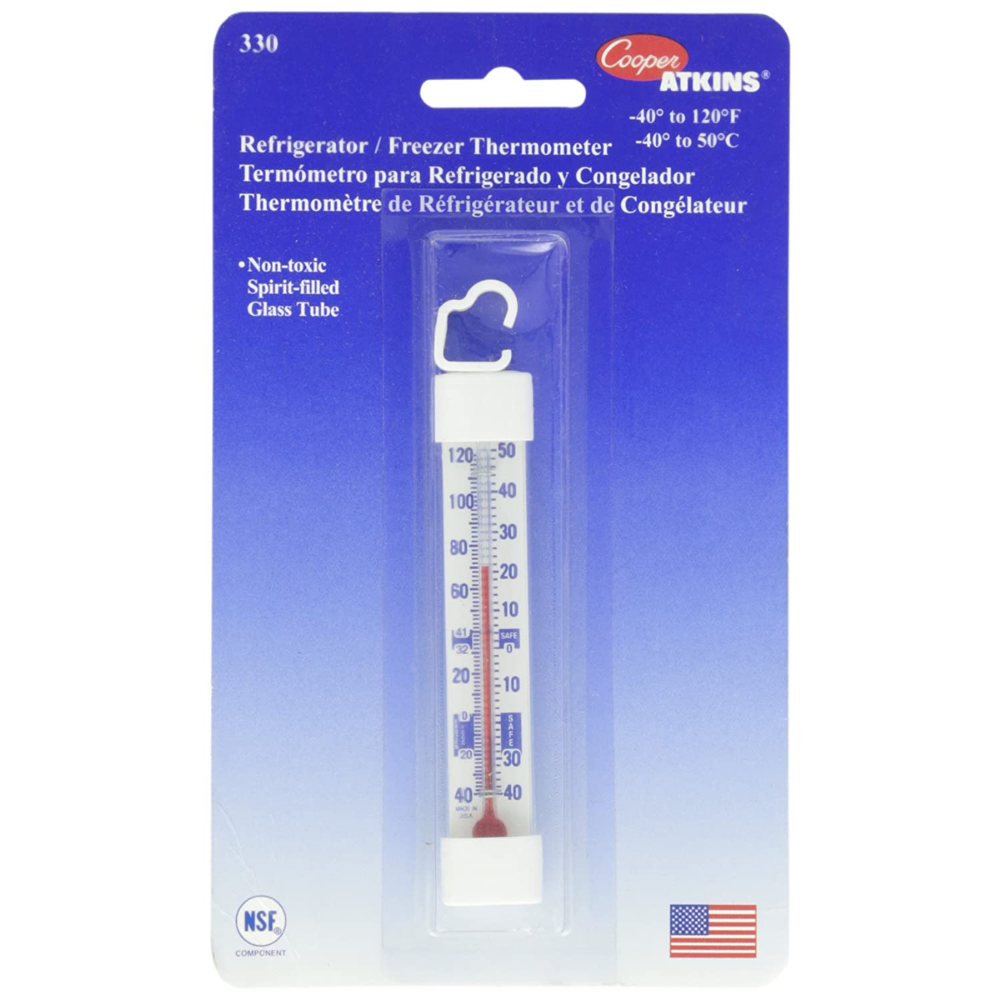
Cooper-Atkins Thermometer
The Cooper-Atkins thermometer offers a straightforward, no-frills approach to temperature measurement. Its simplicity and accuracy make it a valuable choice for those who want a functional thermometer without spending much.
What We Love:
- Compact Design: Takes up minimal space, perfect for small fridges.
- High Precision: Accurate within +-2°F/+1°C.
- No Batteries: Mechanical design means no batteries to replace.
- Food Temp Chart: Comes with a guide for ideal food storage temperatures.
- Durable: End caps protect against accidental drops.
What to Keep in Mind:
- Basic Features: No alarms, wireless capabilities, or digital displays.
- Limited Mounting: Does not include a stand or multiple mounting options.
Why It Might Be Right for You:
The Cooper-Atkins Tube Thermometer is ideal for budget-conscious consumers who need a straightforward, reliable solution. If you prefer a no-nonsense approach and don't need extra features like digital displays or alarms, this thermometer's simplicity and precision will meet your needs perfectly. It's especially suitable for small kitchens or secondary fridges where space is at a premium.
Customer Review (source: Amazon)
I was surprised by the quality of this compact thermometer, especially given its affordable price. Made in the USA, it came in minimal packaging from Cooper-Atkins. I use it in my fridge/freezer, shifting its location as required. There are two small markings for the right freezer and fridge temperatures. It's versatile, fitting even in a shot glass, and while you need good eyesight, the scale is readable. I'd definitely repurchase.
4. Best Splurge
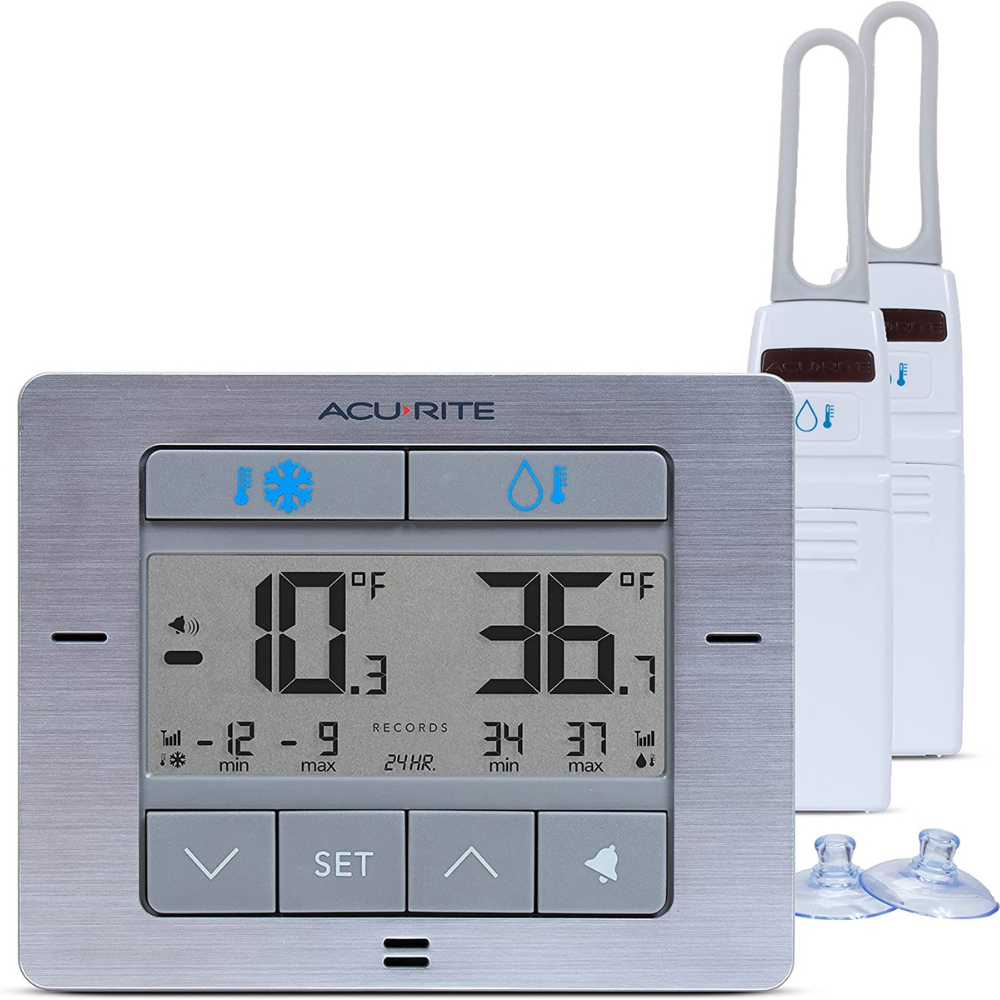
AcuRite Digital Wireless Thermometer
The AcuRite thermometer offers wireless capabilities, allowing for remote monitoring and setting of alarms. This advanced functionality, combined with its user-friendly design and features, makes it the ideal choice for those willing to invest a bit more for added convenience.
What We Love:
- Dual Sensors: Monitors both your fridge and freezer simultaneously.
- Wireless Design: Easy sensor placement and a range up to 100 feet.
- Programmable Alarms: Custom alerts for high and low temperatures.
- Large Display: The readings are easy to see from a distance.
- Mounting Options: Magnetic backing, keyhole for wall mounting, and a foldout stand.
- Multipurpose Straps: Comes with silicone straps and suction cups for versatile placement.
What to Keep in Mind:
- Battery Required: Unlike mechanical models, this one needs batteries.
- Limited Wireless Range: Sensors need to be within 100 feet of the display.
Why It Might Be Right for You:
Ideal for those managing two refrigerator thermometers, the AcuRite Digital Wireless model simplifies monitoring both your fridge and freezer. It's a top choice for tech enthusiasts or busy households needing to keep an eye on multiple cooling units. With its wireless capabilities and programmable alarms, this thermometer offers peace of mind and high-tech convenience in one package.
Customer Review (source: Amazon)
I bought this thermometer after a freezer mishap with my old refrigerator cost me a lot. Setting it up was mostly easy, but I faced an issue where the readings were off. After hitting the "reset" button, it worked perfectly. Remember to use lithium batteries for the freezer sensor. I love that I can check temperatures without opening the fridge. And while I can't vouch for absolute accuracy, the readings seem consistent. The built-in minimum and maximum temp settings and potential alarm feature are a plus. This device is more than just a tool, it's peace of mind. Trust me, you don't want to face a spoiled food disaster; it's costly and frustrating.
5. Best Waterproof
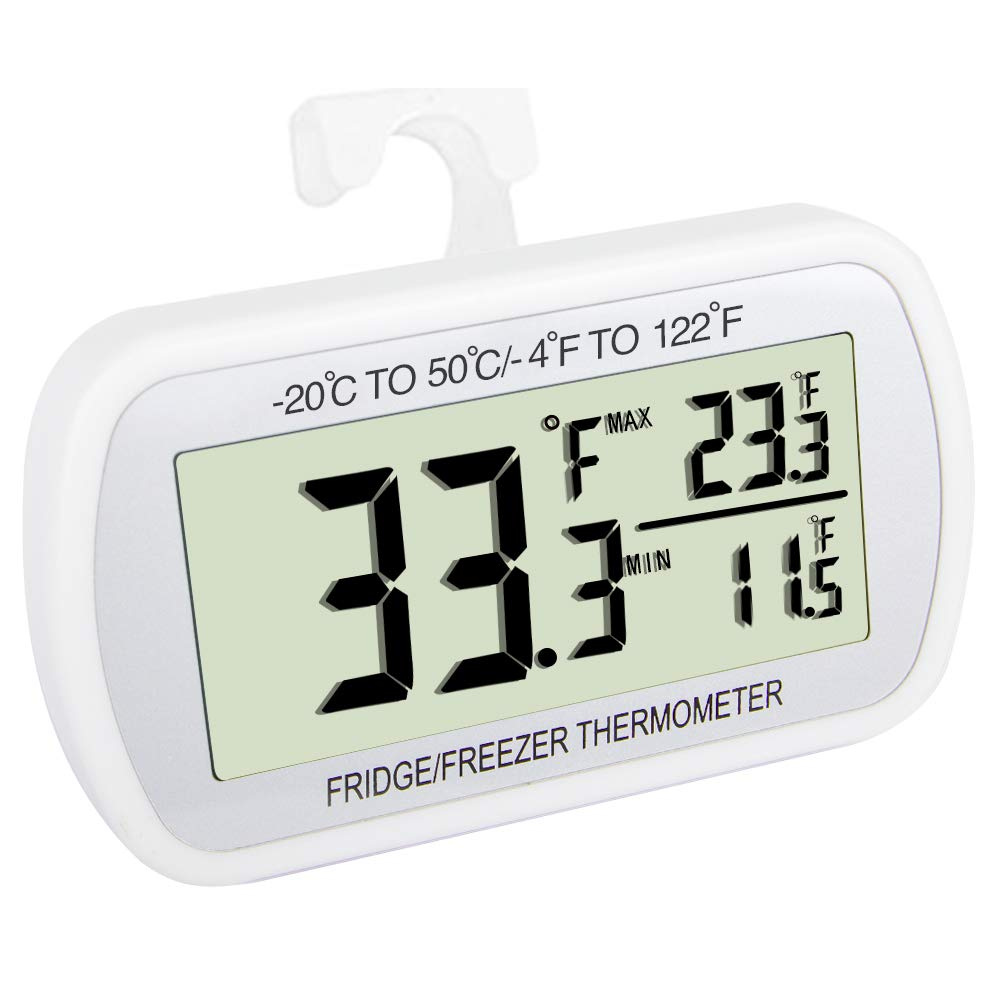
Vouloir Waterproof Thermometer
The standout feature of the Vouloir thermometer is its waterproof design, which allows it to work efficiently even in damp environments. Its large LCD, intuitive controls, and versatile placement options make it a top choice for those who prioritize a waterproof feature in their fridge thermometer.
What We Love:
- Affordability: Budget-friendly without compromising features.
- Wide Temperature Range: Accurate from -4°F to 122°F.
- Ease of Use: Simplified operation with only three buttons.
- Large Display: 2.56-inch LCD shows current, max, and min temperatures.
- Placement Flexibility: Stand, hang, or attach via magnets.
- Waterproof: Designed to withstand the dampness in fridges and freezers.
What to Keep in Mind:
- Limited Features: Lacks programmable alarms or dual sensors.
- Not NSF Certified: Does not have the food safety certification.
Why It Might Be Right for You:
The Vouloir Waterproof Freezer/Refrigerator Thermometer is a great choice for those in humid climates or with busy, spill-prone kitchens. If you need a durable, easy-to-use thermometer that can withstand moisture without sacrificing functionality, this is the one for you. Its waterproof design and large LCD make it perfect for anyone from students in dorms to families who need a resilient, reliable way to monitor their food's temperature.
Customer Review (source: Amazon)
I recently purchased this thermometer and it's been a game-changer for me. My old one was giving inconsistent readings which worried me. But with this new one, even after keeping the fridge open for a while, it shows accurate temperatures once settled. Given the frequent power outages in my area, knowing the highest temperature reached by my fridge during such times is reassuring. I no longer have to worry about food safety. Considering its price, this thermometer is a valuable addition to my kitchen, and I've already suggested it to my friends.
How We Chose The Best Options
Choosing the ideal thermometer for your needs can be daunting with so many options out there. We understand that everyone has different requirements, and going through endless reviews and product details is not easy. Our approach combines extensive research, including customer feedback and Amazon reviews, to assess each thermometer's performance, durability, and user-friendliness. We don't just rely on product descriptions; our editors deeply investigate each brand's history, product specifics, and consumer opinions. This thorough analysis helps us provide well-informed recommendations, ensuring you find a thermometer that's just right for your home.
How to Check Freezer Temperature Without a Thermometer
Checking your freezer temperature without a thermometer can be a bit of a challenge, but there's a simple trick you can use to get a rough idea of how cold your freezer is. Here's a method you can try:
The Ice Cube Test:
- Fill a Small Container with Water: Take a small container or an ice cube tray and fill it with water.
- Place in Freezer: Put the container in your freezer and let the water freeze into ice.
- Check the Ice: After the water has frozen, place a coin on top of the ice and leave it in the freezer.
- Observe the Coin: Check the position of the coin after a few hours or the next day. If the coin has sunk or fallen to the bottom of the container, it indicates that the freezer temperature has risen enough for the ice to partially melt and then refreeze, which means your freezer isn't staying at a consistently cold temperature. Ideally, the coin should remain on the top layer of the ice, indicating that the temperature is stable and cold enough to keep foods frozen.
Remember, this method won't give you a precise temperature reading like a thermometer would, but it's a useful way to gauge if your freezer is functioning properly or if it might be having trouble maintaining a consistent, cold temperature.
How to Calibrate a Fridge or Freezer Thermometer: Mechanical Thermometers
Ice Water Method:
- Fill a glass with ice cubes, then top it off with cold water.
- Stir the mixture well and let it sit for about 3 minutes to stabilize.
- Submerge the sensing part of the thermometer in the ice water without letting it touch the sides or bottom of the glass.
- Wait for the thermometer to stabilize (about 30 seconds to a minute).
- It should read 32°F (0°C). If it doesn't, adjust the thermometer to this temperature. Many thermometers have a calibration nut under the dial that can be turned to adjust the reading.
Boiling Water Method:
- Boil a pot of water and let it reach a rolling boil.
- Submerge the thermometer in the boiling water without touching the sides or bottom of the pot.
- Wait for the thermometer to stabilize.
- The thermometer should read 212°F (100°C) at sea level. Adjust for elevation if necessary, as boiling point decreases with altitude.
- If the reading is off, adjust the thermometer accordingly.
Note:
- Always refer to the manufacturer's instructions for specific calibration methods for your thermometer model.
- Be cautious when handling boiling water to avoid burns.
- Remember that the boiling water method is not suitable for freezer thermometers that have a lower maximum temperature reading.
- Regular calibration (every six months or as recommended by the manufacturer) ensures that your thermometer remains accurate and reliable.
Selecting the Best Refrigerator Thermometer: What to Consider
Digital Vs. Analog: Digital fridge thermometers, with their large LCD screens, offer recent low and high-temperature readings, giving you a clear understanding of both your refrigerator and freezer temperature. Analog or mechanical thermometers, on the other hand, with their sharp red indicators, are equally clear.
Battery Vs. Non-Battery: Keep in mind that batteries of fridge thermometers may need a replacement every 3 to 6 months. Consider this aspect for both cost and convenience.
Construction: Choose fridge thermometers protected by robust materials such as stainless steel or sturdy plastic. These can withstand the frequent jostling inside a refrigerator freezer.
Display: Be it digital or analog, a clear display is crucial. Look for refrigerator thermometers with extensive digital displays or those with LED lights for easier temperature readings, especially in dim lighting.
Temperature Range: Ensure your thermometer can effectively gauge the freezer temperature as well as the refrigerator's. A range of 20 to 80°F or up to 30°C usually suffices for most homes.
Accuracy: Precision matters. An accurate refrigerator thermometer typically has a 2 to 3-degree margin of error. This trustworthiness is essential for ensuring food safety.
Placement Options: Your refrigerator thermometer should have multiple placement options. Some can stand on flat surfaces, while others can hang or come equipped with a temperature sensor that can be affixed at different spots.
Waterproofing: Opt for waterproof thermometers, especially if you plan to use them in outdoor settings. An anti-fog display is a plus!
Legibility: A fridge thermometer should be easy to read. Big numbers on digital displays or color-coded zones on analog ones help ensure you get a quick read, preventing any unwanted surprises in your refrigerator freezer.
Frequently Asked Questions & Inquires
How to check fridge temperature without a thermometer:
To get an accurate temperature reading of your fridge without a thermometer, use the ice water method. Fill a container with water, place it in the fridge, and let it sit for about 8 hours. If the water freezes, the refrigerator temperature is too cold. For more precise and consistent monitoring, consider using digital refrigerator thermometers.
How to read a fridge thermometer:
Reading a fridge thermometer, especially digital refrigerator thermometers, is straightforward. Place it in the central area of the fridge, away from cooling elements. After 20 to 30 minutes, check the reading. The ideal refrigerator temperature should be around 40°F (4°C). If your thermometer has color-coded zones, ensure it's within the safe temperature range.
How do you read a freezer thermometer:
To read a freezer thermometer, place it in the center of the freezer for an accurate temperature reading. After about 15 to 30 minutes, a properly functioning freezer should show 0°F (-18°C) or below. This applies to both digital and mechanical types of refrigerator or freezer thermometers.
Where to place a fridge thermometer:
For the most accurate temperature reading, position your fridge thermometer, be it digital or mechanical, in the central part of the refrigerator. This placement ensures it accurately reflects the overall refrigerator temperature, away from fluctuating areas like the door and crisper drawers. Regular monitoring with a refrigerator or freezer thermometer helps in maintaining optimal food storage conditions.
Where to place a freezer thermometer:
Place your freezer thermometer, whether digital or a mechanical thermometer, in the central part of the freezer for the most accurate temperature reading. Avoid areas near the door to prevent skewed readings from frequent openings.
Items reviewed:
- Best Overall: Rubbermaid Thermometer
- Editor's Choice: Taylor Precision Thermometer
- Best on a Budget: 4. Cooper-Atkins Thermometer
- Best Splurge: AcuRite Digital Wireless Thermometer
- Best Waterproof: Vouloir Waterproof Thermometer

Best Overall: Rubbermaid Thermometer
Rubbermaid is a reputable brand, known for durability and reliability. Its thermometer offers both durability with its stainless steel construction and accuracy with its easy-to-read dial. It’s an all-rounder that can be trusted to deliver consistent performance.
Please note that the reviews on this page have been edited for readability and clarity while maintaining the essence of the original content.
Further Reading
- Discover the top 5 reasons why a fridge thermometer is vital for your kitchen and how it can help you avoid foodborne illness.
- If you're keen on optimizing food preservation in your kitchen, you won't want to miss this informative article by Forbes Home on the ideal refrigerator temperature.



